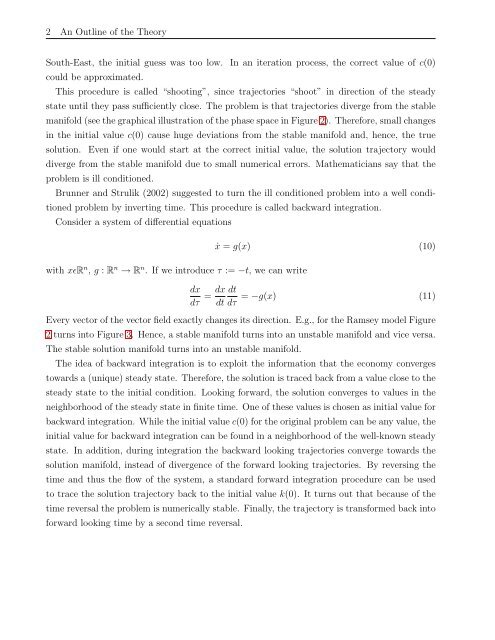Dynamic Macroeconomic Modeling with Matlab
Dynamic Macroeconomic Modeling with Matlab
Dynamic Macroeconomic Modeling with Matlab
You also want an ePaper? Increase the reach of your titles
YUMPU automatically turns print PDFs into web optimized ePapers that Google loves.
2 An Outline of the Theory<br />
South-East, the initial guess was too low. In an iteration process, the correct value of c(0)<br />
could be approximated.<br />
This procedure is called “shooting”, since trajectories “shoot” in direction of the steady<br />
state until they pass sufficiently close. The problem is that trajectories diverge from the stable<br />
manifold (see the graphical illustration of the phase space in Figure 2). Therefore, small changes<br />
in the initial value c(0) cause huge deviations from the stable manifold and, hence, the true<br />
solution. Even if one would start at the correct initial value, the solution trajectory would<br />
diverge from the stable manifold due to small numerical errors. Mathematicians say that the<br />
problem is ill conditioned.<br />
Brunner and Strulik (2002) suggested to turn the ill conditioned problem into a well condi-<br />
tioned problem by inverting time. This procedure is called backward integration.<br />
Consider a system of differential equations<br />
<strong>with</strong> xǫR n , g : R n → R n . If we introduce τ := −t, we can write<br />
dx<br />
dτ<br />
˙x = g(x) (10)<br />
dx dt<br />
= = −g(x) (11)<br />
dt dτ<br />
Every vector of the vector field exactly changes its direction. E.g., for the Ramsey model Figure<br />
2 turns into Figure 3. Hence, a stable manifold turns into an unstable manifold and vice versa.<br />
The stable solution manifold turns into an unstable manifold.<br />
The idea of backward integration is to exploit the information that the economy converges<br />
towards a (unique) steady state. Therefore, the solution is traced back from a value close to the<br />
steady state to the initial condition. Looking forward, the solution converges to values in the<br />
neighborhood of the steady state in finite time. One of these values is chosen as initial value for<br />
backward integration. While the initial value c(0) for the original problem can be any value, the<br />
initial value for backward integration can be found in a neighborhood of the well-known steady<br />
state. In addition, during integration the backward looking trajectories converge towards the<br />
solution manifold, instead of divergence of the forward looking trajectories. By reversing the<br />
time and thus the flow of the system, a standard forward integration procedure can be used<br />
to trace the solution trajectory back to the initial value k(0). It turns out that because of the<br />
time reversal the problem is numerically stable. Finally, the trajectory is transformed back into<br />
forward looking time by a second time reversal.
















